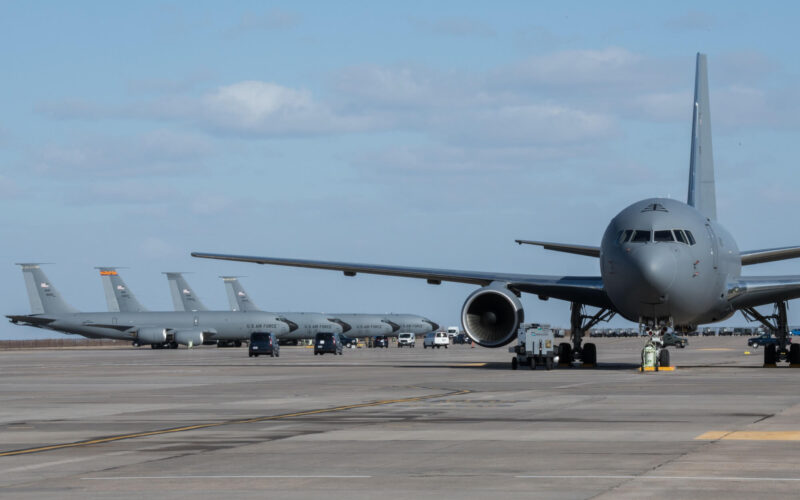Following the induction of the Boeing KC-46 Pegasus tanker on January 10, 2019, multiple voices pointed at the problems that the aircraft, marred by technical deficiencies, could cause to the aerial refueling capacities of the United States Air Force (USAF).
Two years later, the situation does not seem to have improved by much. In a surprising manner, the US Transportation Command (USTRANSCOM) in charge of power projection capabilities of the US military declared in a tweet that the capacity gap of the air refueling fleet put “America’s ability to effectively execute day-to-day operations and war plans at risk.”
#DYK, the convergence of an aging air refueling (AR) fleet, with protracted KC-46A production and delays of becoming fully mission capable, puts America’s ability to effectively execute day-to- day operations and war plans at risk. #TogetherWeDeliver pic.twitter.com/tT0YnXy5ne
— USTRANSCOM (@US_TRANSCOM) February 1, 2021
The same day, Jacqueline D. Van Ovost, Commander of the Air Mobility Command, said she estimated the KC-46 would not be operational before late 2023 at best. “We are doing everything we can to accelerate this,” Van Ovost explained, as reported by Defense One. “We’re doing everything we can to accelerate that.”
Exceeding the red line
This is but the last in a long list of warnings coming from the USAF. Speaking at the Atlantic Council in January 2020, General Stephen R. Lyons, commander of USTRANSCOM, said the U.S. military was “exceeding the red line,” both for its own needs and those of its allies.
The KC-46 Pegasus was supposed to replace the KC-135 Stratotanker and KC-10 Extender and reinforce the thin-stretched refueling capacities, with the entire KC-10 fleet to be withdrawn within the next five years. The Air Force has ordered 94 of a planned fleet of 179 KC-46 tankers. 42 were already delivered.
But the aircraft has encountered numerous technical problems since its delivery. Recently, Boeing managed to find a fix for two “critical deficiencies” affecting the auxiliary power unit of the Pegasus. But three others were identified, and those could still take years to fix.
Upon delivery of the first aircraft on January 10, 2019, more than a year after the due date, it came to light that the “Remote Vision System” (RVS), developed by Rockwell Collins, did not work as intended, especially under certain light conditions. The RVS is composed of several sensors and cameras that should help a boom operator during aerial refueling. But the USAF has discovered discrepancies between the motion shown by the RVS and what was happening in real life.
Another problem was the design of the boom itself. During aerial refueling, both the tanker and the receiving aircraft must work together to connect the nozzle of the boom to the receptacle of the aircraft. However, multiple aircraft within the USAF, including the A-10 ground attack aircraft, were found unable to generate sufficient thrust to connect. Boeing was awarded $55.5 million by the USAF to fix it.
Finally, “excessive fuel leaks” were discovered during a refueling test in July 2019. “In some cases with this issue, aircraft maintenance crews are finding fuel between the primary and secondary fuel protection barriers within the system,” Boeing reported. As per the contract, it is now up to the manufacturer to find a fix for this new problem – on its own funds.
In its financial results for 2020, Boeing reported a new $275 million charge for the deficiencies of the KC-46 Pegasus. That put the total cost overruns of the program at above $5 billion, exceeding the initial cost of the contract with the USAF at $4.9 billion.
One company’s troubles is another one’s opportunity
As it is, the KC-46 cannot operate at full capacity. At a Congressional hearing on March 3, 2020, General David Goldfein, Chief of Staff of the U.S. Air Force, said he would only send the KC-46A in a contested environment if absolutely necessary. “We won’t use it for day-to-day operations, but it will be made available for a contingency,” Goldfein said.
To reduce the stress on its capacity, the USAF resorted to private contractors. On September 30, 2020, the Washington D.C.-based company Meta Aerospace announced acquiring four KC-135R formerly operating with the Republic of Singapore Air Force. “With its extensive defense-as-a-service offerings and air mobility experience, this addition of four KC-135R aircraft enables Meta to deliver turnkey aerial refueling services to meet our U.S. Government customer’s requirements,” the company wrote in a statement.
The ongoing problem also caught the attention of other manufacturers. In December 2018, Lockheed Martin and Airbus signed a memorandum of agreement to “jointly explore opportunities to meet the growing demand for aerial refueling for US defense customers.”
It was Airbus (partnered with Northrop Grumman at the time) that initially won the KC-X tender launched by the Pentagon for a new refueling system to equip the United States Air Force. With its A330 MRTT already in production, the European manufacturer was way ahead of its American rival whose KC-46 Pegasus was still on the drawing board. However, political concerns invited themselves into the acquisition process, and after several years of lobbying, the contract was eventually taken away from Airbus and given to Boeing.
But the European manufacturer could have another shot. In November 2020, Jacqueline Van Ovost said the USAF was ready to move forward with the second program aimed at renewing its fleet of aerial refuelers. Formerly known under the codename KC-Y, the competition should once again see Boeing face Airbus in partnership with Lockheed Martin.

